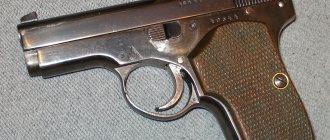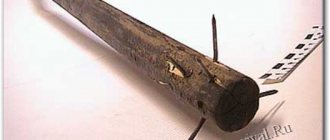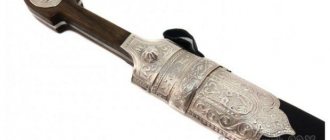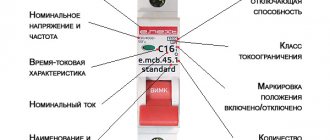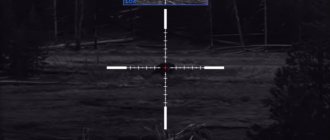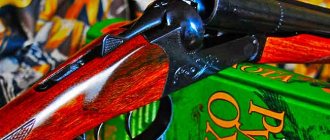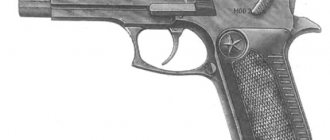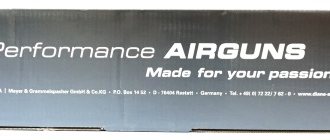Many novice hunters sooner or later ask the question: “Chock and pay: what is it?” And few of them know that in this case we are talking about the muzzle narrowing. This parameter has a direct impact on shooting; it determines the use of cartridges, expansion parameters, etc. For beginners, such terms can raise a number of questions, and therefore they should be considered in more detail.
A little history
To figure out what chok and pay are, you need to turn to the historical summary. The choke was invented by American hunter Fred Kimble back in 1870. The impetus for the creation of a muzzle narrowing was the fact that a strong scree appeared in a gun with a cylindrical drill. It was quite logical to assume that if the barrel of the weapon was slightly narrowed, then in this way it would be possible to reduce spread and create a better accuracy of the shot.
However, after narrowing the barrel of the gun, Kimble got even worse results, which forced him to abandon the idea. The reason for the hunter's failure was his lack of precise measuring instruments. Then, having returned the gun to its original state, Fred Kimble fired a shot and was amazed at the density and accuracy of the shot.
A similar effect was achieved for the reason that as a result of all the manipulations, the gun retained a slight narrowing, thereby causing a significant difference in shots. The achieved result did not prompt Fred Kimble to patent the invention, but this would have been pointless, since 10 years earlier the British Marcus Pape had already invented a cone-shaped barrel narrowing.
This is interesting. The narrowing technology in Europe is called conical, and Americans call it American.
Chock and pay: what is it?
Chok was invented in the 19th century.
To better understand the terminology, you should consider the meaning of the concepts chok and pay. Choke is a narrowing of the muzzle that facilitates shot shooting and affects the accuracy of the shot. It is also called a bell.
You need to understand that a strong, medium choke or payoff are very relative guidelines that depend on the manufacturer. For example, a regular choke from various companies may require a narrowing of 0.75, 0.9 or 1 mm.
It should also be noted that the accuracy of the shot depends not only on the amount of constriction, but also on the shape of the choke itself.
Types of choke constrictions
Types of choke constrictions
The types and shapes of choke offered by various manufacturers can most easily be considered using the example of a 12-gauge weapon. For guns of other calibers, the names of the terms remain the same, but the sizes may differ significantly:
- Cylinder. Assumes a minimum choke constriction of up to 0.21 mm. In some models it is completely absent, which ensures combat accuracy of around 40%. The scree turns out dense, uniform and wide. The cylindrical barrel is an excellent option for using any bullets and is suitable for close-range shooting.
- Weak pay. This narrowing is also called a pressure cylinder. We are talking about a slight narrowing of the muzzle, reaching 0.25 mm. The accuracy in this case is 45%. Thus, the circle of dispersion will be smaller compared to shooting from a classic cylinder. Due to the slight narrowing, such guns are suitable for using any type of cartridge.
- Payday. This type of narrowing does not exceed 0.5 mm. At the same time, the accuracy of combat can reach up to 55%, making such a weapon an ideal choice for shooting shotgun or buckshot. Experts advise using round bullets with caution. Projectiles with belts or a polyethylene container can only be used if there is a gap of 0.5 mm or more between the barrel and the bullet. The same applies to the use of any weapon with a choke type choke. When shooting from a “poluchok” type muzzle, you should maintain a distance of 25-40 meters.
- Medium choke or ¾ choke. Narrowing to 0.75 mm makes it possible to achieve a shooting accuracy of 60%. Guns designed to hit long-range targets have these characteristics. Such weapons perform well when using both shot and buckshot of various types. You can also use round bullets, but in this case they must pass freely through the narrowed parts of the barrel. Otherwise, it may rupture.
- Chock. Classic choke, which is one of the most popular. Due to the shooting range and good accuracy, such barrels are suitable for both hunting and sports disciplines. Narrowing the muzzle to 1 mm made it possible to obtain an accuracy of about 70%. Using buckshot and coarse shot to choke the choke does not allow obtaining a uniform result. Therefore, experts advise using shot of small and medium diameter. In this case, acceptable shot accuracy is achieved. In this case, so-called “windows” may appear between the pellets. For specialty and round bullets, a full choke is fine, but should be fired with caution. The firing range will be the maximum possible.
- Strong choke. The narrowing in this case can reach 1.25 mm with an accuracy of about 85%. This option is perfect for sports clay pigeon shooting and other disciplines that require long-distance shooting. A good option for amateur shooting and hunting using an optical sight. The size of the projectiles should not exceed number 7. If you use larger shot or buckshot in such a weapon, this can lead to the barrel rupturing or serious damage to it, which makes further use of the weapon impossible.
- Drill with socket. This is a variant of a strong choke, which involves a slight expansion of the barrel with its gradual narrowing. This option is optimal when hunting at short distances and using small shot. The grouping of the scree is wide and even, which is the main advantage of this type of trunk. The optimal shooting distance is 15 meters. At distances exceeding 20 meters, accuracy deteriorates significantly.
- Rifled choke. This narrowing of the muzzle is also called “paradox”. This weapon is designed to fire a special type of bullet and is most often used for hunting large animals. The shot distance is 100-150 meters. Regarding the accuracy of the combat, this type of barrel can be compared with the classic half-shot, but allows you to fire more powerful shots at long distances.
- Very strong choke. This choke reaches 1.45 mm and is used in some models of sporting shotguns. Designed for long-range shooting and has good accuracy. It should be understood that for weapons with a very strong choke, you can only use small shot, which does not exceed the size of No. 8. It is undesirable to use round bullets and buckshot due to the danger and absolute unpredictability of the behavior of such projectiles.
About removable attachments
The main role of the removable barrel attachment is to improve the quality of the hit when firing.
They are most often used by IPSC sports shooters or hunters. In this case, a very important parameter is the accuracy of the battle, since such weapons fire shotguns at short distances. Attachments of this type are produced for 12-gauge Saiga and Vepr shotguns. The nozzle on the Saiga may require a thread for a stationary choke or a removable choke. Its main function is to reduce the accuracy of fire at various distances.
Although chokes were originally built-in, most chokes today are removable, making them highly versatile. Thus, by purchasing several options for attachments, the hunter can gain real freedom of choice. It will not depend on the “factory” narrowing.
Notes
- ↑ 1 2 3
Forgotten “paradox”
(undefined)
(inaccessible link -
history
). Kaliningrad hunting club. - “Hunting and game management”, No. 1/1983. Accessed March 17, 2011. - ↑ 1 2 3 Alexey Blum.
Paradoxes—history or perspective?
(unspecified)
(inaccessible link). Magazine "Weapons" (July 23, 2009). Retrieved March 18, 2011. Archived September 11, 2009. - ↑ 1 2 3 4 Ed.
V.E.German. Handbook for hunter-sportsman. - M.: Physical culture and sport, 1954. - T. 1. - P. 173. - 399 p. — 50,000 copies. - The device of the gun (undefined)
. Zhevelo.com - Hunting (November 11, 2010). Retrieved March 20, 2011.
Choosing a nozzle: what should you pay attention to?
Weapon parameters such as combat accuracy or scree type are rather arbitrary. The type of scree is largely determined by the characteristics of the shot, the caliber and length of the barrel. And only lastly is this parameter determined by the nozzle itself. It should also be understood that the actual degree of narrowing is somewhat different from that indicated in the documents, and therefore the shot performance in this case will be different.
For example, incomplete correspondence between the barrel axes and the characteristics of the muzzle attachment can significantly affect shooting accuracy. This factor will be especially noticeable when shooting bullets. If you use shot as cartridges, then the accuracy will suffer slightly.
The most popular chokes manufacturers
Choke attachment “Paradox” produced by the “Molot” plant
Currently, attachments for guns are produced by both popular brands and little-known companies. Since we are talking about firearms, it is better to give preference to the first option. And the point is not only in the best indicators of accuracy and accuracy, but also in the basic safety of the shooter.
Of the domestically produced attachments, the most popular are products from the Tula Defense Plant and the Machine-Building Plant. However, there are many foreign-made chokes on the Russian market. Let's look at the most popular options:
- Briley. The company produces a large number of various variations of chokes that are compatible with most modern models of smoothbore shotguns.
- Comp-N-Choke. Manufacturer of chokes for sporting and hunting shotguns of 10-20 caliber. The products are of very high quality.
- Kick's. Manufacturer of bird hunting attachments for 10 and 12 gauge shotguns. It produces various nozzles, both pressure cylinders and pressure chokes.
The abundance of choke tubes on the market today has greatly expanded the capabilities of both sports shooters and hunters. Today, all serious weapon manufacturers produce their own lines of attachments.
Bullets for "paradoxes"
Paradox bullets have a characteristic shape, unlike the shape of shotgun bullets, which are stabilized by either an arrow-shaped stabilizer or rotation by an oncoming air flow (for example, a Mayer or Brenneke bullet).
Bullet for "paradox" 12 gauge. The circular groove is filled with stearin. Classic Brenneke bullet used in smooth-bore hunting weapons.
“Paradox” bullets are close in shape to bullets of conventional rifled weapons - they, as a rule, have a conical shape, with one or two leading belts. For better obturation, these belts, when loading a bullet into a cartridge case, are filled with stearin, paraffin, wax or other similar material, or wrapped with salted thread [3].
The initial flight speed of the bullet is from 400 to 425 m/sec. The bullets are usually unjacketed, made of lead, but some models are equipped with a thin cap - a ballistic tip, made of copper or brass. Paradox bullets usually weigh more than smoothbore bullets of the same caliber and have significantly greater stopping power[3].
